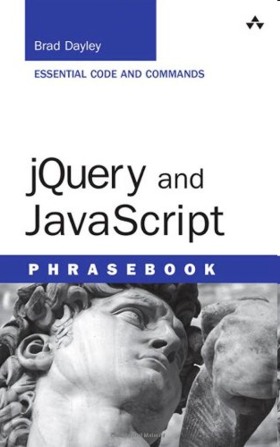| jQuery and JavaScript Phrasebook |
Author: Brad Dayley
Pocket books, or phrasebooks in this case, are something that provide a unique form of summary of a topic. Can you provide a pocket reference for a subject as big as jQuery and JavaScript? jQuery has more or less become the standard library of JavaScript and it does make sense to deal with them together. You could say knowing how to use jQuery is part of learning to program in JavaScript. If you don't agree with this then you probably don't want a copy of this book because the amount of coverage of pure JavaScript is mostly limited to the first three chapters, i.e. not much.
Chapters 1, 2 and 3 are a basic guide to JavaScript and using it in the browser without much jQuery. This is more a refresher than an in-depth tutorial. If you program, in some other language then you might find this helpful. However it is so short that it fails to explain some of the JavaScript idioms that you will find in jQuery. Chapter 4 deals with accessing HTML elements and, as this is what jQuery was originally designed for, it isn't unreasonable that this focuses on using jQuery to write selectors. Chapter 5 pushes these ideas further with an examination of how you can manipulate the jQuery object set, i.e. what jQuery returns from a DOM query. This is also where you learn basic jQuery idioms such as iterating though collections and functional ideas such as using map. Chapter 7 shows you how what you have learned can be put to use in manipulating page elements dynamically. Chapter 8 moves on to consider manipulating the entire layout dynamically including resizing and positioning elements. Chapter 9 continues the application of the dynamic modification to form elements.
The next chapter gets slightly more adventurous in it uses jQuery to build a page, or part of a page, by creating and inserting new DOM elements using jQuery. Once you get the idea you quickly discover that you can do just about anything and might think why bother with HTML at all. Chapter 11 moves on to a completely different topic - jQuery UI. This really isn't core jQuery and not everyone using jQuery will want to extend their use to the UI components provided by jQuery UI. It deals with autocomplete, drag and drop, datepicker, sliders menus and tooltips. Of course there are lots of other UI elements provided as addins. The next chapter returns to core jQuery with a look at animation, but it continues the previous chapter's focus on the UI. Animation can be applied to any HTML element or indeed any CSS style property. Chapter 13 changes topic completely and introduces jQuery-based Ajax. This would probably be better introduced earlier, but it is an advanced and difficult topic so perhaps later is indeed better. It explains how to do Ajax using raw JavaScript and then shows how much easier it is using jQuery. It also covers working with JSON. The final chapter goes off into another non-core jQuery topic - jQuery mobile. Again, not every jQuery user selects jQuery mobile for their mobile UI. It provides a short, 15-page, introduction to a library that probably could fill another phrasebook on its own.
So does the book work? Yes, but only if your main interest is jQuery - the JavaScript in the title might as well be dropped as you really do need to know how to program in JavaScript reasonably well to get much out of it. It is also important to realize that the size of the book means that each section is very short and there are no very long examples. If you are looking for a brief explanation then this is all the better. While it does go through the material in a mostly logical order it isn't a reference work. You could, however, use it as a "cheat sheet" for discovering how to do particular tasks. Overall I liked this book. There are enough helpful boxouts pointing out things you might not have realized to make it useful to the intermediate jQuery programmer as well as beginner. It isn't going to replace a big book of words, but it is handy to have around. This title is included in JavaScript Beginners Book Choice in our Programmers Bookshelf section.
|
|||
| Last Updated ( Wednesday, 28 February 2018 ) |


